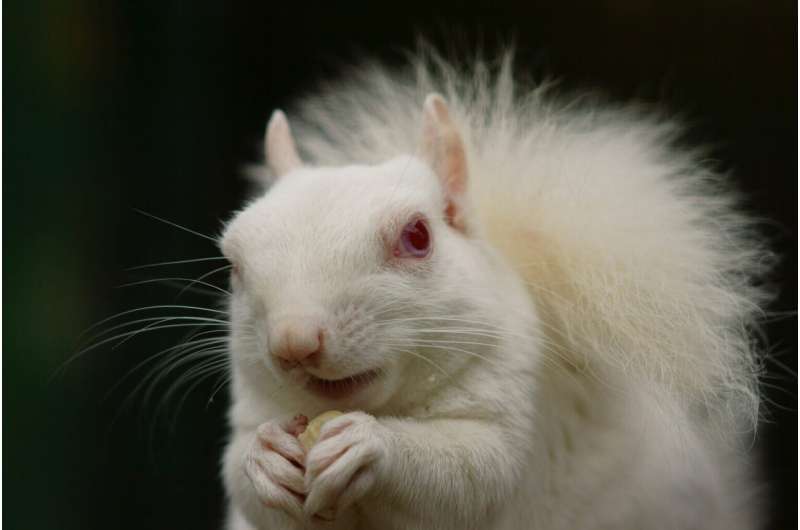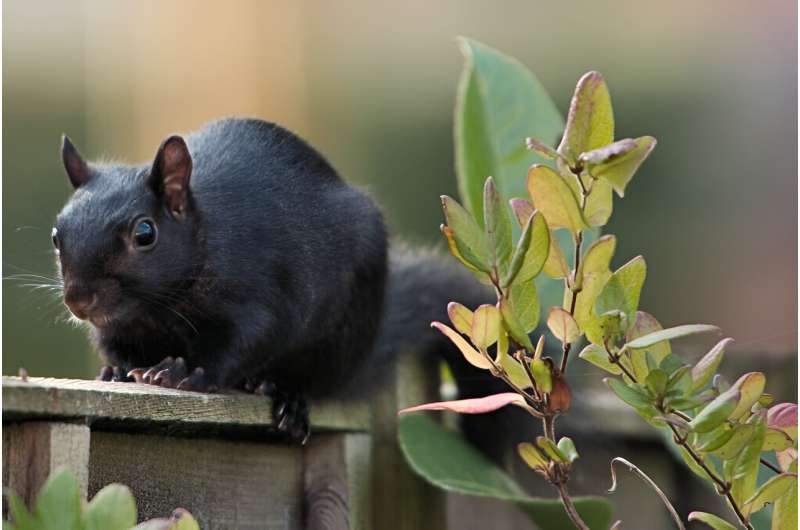This article has been reviewed according to Science X's editorial process and policies. Editors have highlighted the following attributes while ensuring the content's credibility:
fact-checked
peer-reviewed publication
trusted source
proofread
How color shapes which animals we fear—and which we protect

Around the world, animals that exhibit rare color morphisms—including lighter-colored variants with albinism or leucism and dark-colored variants with melanism—are often the subject of both veneration and fear in humans.
A study in Human Ecology by wildlife biologists at UC Berkeley, the University of Washington, and Washington University is one of the first to explore how human preference for these rare color variations impacts how urban wildlife are perceived and treated.
UC Berkeley graduate student and study co-author Tyus Williams for Berkeley News discusses how unconscious human bias shapes which animals we fear and which we protect, and how these biases may reflect deep-seated beliefs about color, lightness, darkness—and even race.
Berkeley News: Why is it important to understand human perceptions of wildlife?
Tyus Williams: As somebody who's Black in science, one of the things I'm always thinking about is that science is a tool, it's a principle. It's a discipline that allows people to critically examine questions about the world and tackle them in a precise manner. But science is only as good as the individual who's performing it.
Humans have evolved alongside animals in ways that have caused us to fear some animals and domesticate others. Conservation scientists may use evidence-based approaches that are informed in research and literature, but they are still human beings with these natural internalized biases and preferences, and who deliberately study groups of animals because they like them.
Because of that, I think we have to critically examine and unpack those feelings so that we can effectively inform the policies that we're trying to implement, and to ensure that we're looking after the animals that we're trying to be stewards for.
What gave you the idea to study color morphs in particular?
It all started with eating Indian food at a postdoc's house, which is where all great scientific ideas stem from. It was me, Elizabeth Carlen and Lauren Stanton. At one point, Liz and I were talking about urban species that are generally ubiquitous, like squirrels and raccoons.
I started wondering whether it was possible that charismatic color morphs might influence how people perceive these animals—whether animals with these novel colorations, like albino squirrels, might be favored, rather than just being seen as commonplace or nuisance species.
I remember saying, "People love jaguars. But people love black panthers. Why is that?" This paper really grew out of questioning why people respond to different types of animals the way they do.
Why did you decide to study urban wildlife that we see all around us, like squirrels, deer and coyotes, rather than black panthers or other threatened species?
I think there's something really interesting about how novel colorations influence human interactions with animals that might otherwise be overlooked or disregarded.
For instance, you may see the local news covering an albino squirrel that has been located in a nearby park. It's still the same species as other squirrels—an eastern gray squirrel or a western gray squirrel. But clearly somebody took the time to cover it.
People often end up gravitating toward these animals or collectively investing in the protection of a sole individual, and I think there's something really fascinating about the psychology of that. What is it about these animals that is quite literally modifying how people interact with them on a daily basis?
What are some of the ways animals with these unique colorations are treated in the U.S.?
We surveyed both news articles and scientific publications for observations of animals with these novel colorations, and we specifically looked at how people were responding to them—were they treated like a nuisance, or did people have a sense of adoration or protectiveness toward them?
We found multiple places in the U.S. where it's illegal to hunt white stags, or albino white-tailed deer. The same doesn't apply to melanistic deer. Interestingly, a lot of the support for the protection of white stags derives from the public, while state biologists say that there's no reason to try to insulate this genetic mutation that doesn't really benefit the species in the long term.
There are also some places in the U.S. where white squirrels have protections. A town called Brevard, North Carolina, hosts a "White Squirrel Weekend" to celebrate its leucistic squirrels, and in 1986, Brevard declared itself a squirrel sanctuary, prohibiting people from killing or harassing squirrels within the city limits.
In the town of Olney, Illinois, white squirrels get right of way when they're crossing the street, and there are legal fines if you harm them with your vehicle.

There are similar celebrations and protections for black squirrels. In one example, the U.S. actually imported 10 black squirrels from Canada and released them at Kent State University in Ohio, and the campus now hosts an annual black squirrel festival to celebrate them. I found it really interesting that people deliberately extracted animals with this novel, charismatic feature in order to have it on their campus grounds.
In general, we found that people seem to be more celebratory and appreciative of herbivores—deer and squirrels—compared to predators like coyotes. However, we did find an example of a black coyote named Carmine in Atlanta, Georgia, that was roaming through neighborhoods and playing with people's dogs in their backyards.
In Georgia, trapped coyotes are required by law to be euthanized, but there was collective support for wanting to save Carmine, and he was instead relocated to a sanctuary to live out the rest of his life.
Humans have evolved to have more vigilance and fear toward coyotes and other predators, and it's interesting to think about how the way that Carmine looked quite literally might have saved his life.
In the U.S., systemic racism—particularly against people of African descent—has created discrimination against people with darker skin tones. Did you find any evidence of a similar prejudice against animals with darker coloration?
One of the things that I thought was fascinating was that there did seem to be a polarity between the lighter and darker variants: A lot of the albino or leucistic animals actually had laws protecting them, but none of the melanistic animals did. This could be because the genetic variants that cause leucism and albinism are more common than those that cause melanism, so people are more likely to encounter lighter variants and strive to protect them.
But it's possible that there is something else going on here. We know that, in the U.S., skin color thoroughly informs the way that we interact with society. There is also a lot of symbolism associated with black and white that shapes how these colors are perceived in both the human and the animal realms. Black is often associated with grief, sadness and dread, and people can perceive the color as evil, as well. White, on the other hand, often represents purity and cleanliness.
When you think about how easily human society can manipulate the fabric of our reality around us, it's not too far of a stretch to assume that it also informs the ways that we interact with wildlife.
Do you think there are downsides to people developing connections with individual animals or groups of animals based on their color or other charismatic features?
I think it's important to think about our relationships to these animals in the context of how we treat other wildlife that is not particularly novel or charismatic. We may love that Carmine was spared, but what about all the other coyotes that don't look like Carmine?
Similarly, deer populations in many regions are very high and are responsible for a significant number of car collisions and vehicle mortality. In many places, people are encouraged to hunt deer—unless the deer have a unique coloration.
If we can let something as simple as color modify how we engage with wildlife, what other biases might be informing our conservation and policy decisions? I think it's really important to hold ourselves accountable and make sure we're doing the best job that we can to ensure that wildlife are being taken care of, even if they don't have these unique features.
How else has being a Black scientist shaped your approach to your work?
As a Black researcher, I really resonate with the idea that people perceive and interact with animals based on the way that the animals physically present themselves, because that's often very akin to the experience of being Black in America. There's only so much that I can control about how I'm perceived, and sometimes I have to dress or code-switch in a certain way to prevent people from making incorrect judgments or assumptions about me.
Overall, I look at how deeply entangled the human world and the natural world really are, and how much they inform each other, and I feel privileged to be able to explore these questions with my peers.
More information: Tyus D. Williams et al, Of Rarity and Symbolism: Understanding Human Perceptions of Charismatic Color Morphs, Human Ecology (2024). DOI: 10.1007/s10745-024-00492-7
Journal information: Human Ecology
Provided by University of California - Berkeley





















